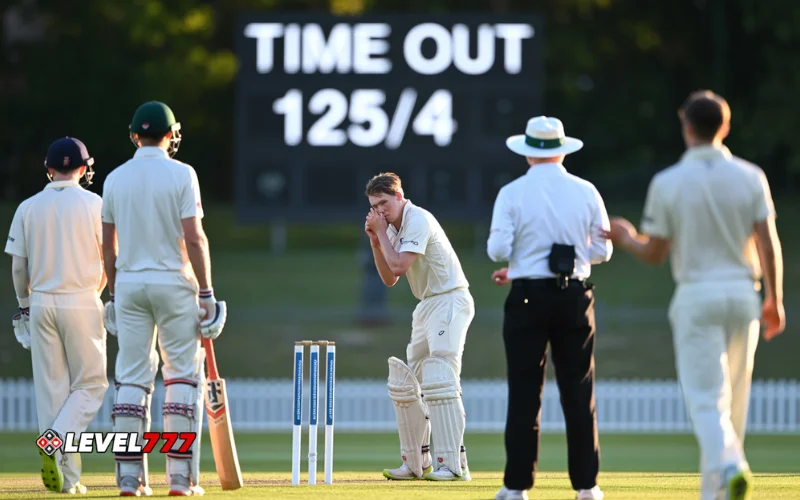Cricket is a sport filled with traditions, strategies, and unique rules that make it stand out from other games. Among the many regulations, the concept of time out in cricket is one that often sparks curiosity and sometimes confusion among fans level777 slot. While it may not occur as frequently as other events on the field, when it does, it has a significant impact on the game. To understand this better, let us explore the nine key rules about time out in cricket that every fan should know.
What is Time Out in Cricket
Time out in cricket is a dismissal that happens when a new batter fails to arrive at the crease within a specific time limit after a wicket has fallen or when play resumes. Unlike other dismissals such as bowled, caught, or leg before wicket, this rule is rare but important because it ensures the game continues without unnecessary delays. It highlights the importance of discipline, punctuality, and fair play in cricket.
Rule 1 The Three Minute Rule
The most important rule about time out in cricket is the three minute rule. According to the laws of the game, when a batter is dismissed, the next batter must take their position at the crease within three minutes. If they fail to do so, the fielding team can appeal for a time out dismissal. This rule is designed to keep the game moving smoothly and avoid wasting time.
Rule 2 The Role of the Umpire
For time out in cricket to be given, the fielding team must appeal to the umpire. The umpire cannot declare a batter out for time out without an appeal. Once the appeal is made, the umpire checks if the three minute time has indeed passed. If it has, the batter is declared out. This ensures fairness and prevents the rule from being misused.
Rule 3 Situations That Lead to Time Out
Time out in cricket usually occurs when a batter is not prepared or delays coming onto the field after a wicket falls. It may also happen if play resumes after a break, and the next batter is not ready to face the ball. Although rare, it emphasizes the importance of being alert and ready to continue the match without delay.
Rule 4 Flexibility in the Laws
Umpires may allow a little flexibility due to practical reasons such as protective gear adjustments or technical interruptions. However, the spirit of the rule remains the same, which is to prevent unnecessary time wasting.
Rule 5 Rare Occurrences in Professional Matches
One of the reasons why time out in cricket fascinates fans is because it is so rare. The rarity makes it a unique event and sparks discussions among commentators and fans whenever it happens.
Rule 6 Responsibilities of the Batter
The batter has the primary responsibility to avoid time out in cricket. They must be ready with their gear and enter the field quickly once a wicket falls.

Rule 7 Team Responsibility
It is not only the batter’s responsibility but also the team’s responsibility to ensure that the next player is prepared. Coaches, team managers, and even teammates play a role in making sure that players know their batting order and are ready to step in. This teamwork helps prevent delays and ensures smooth gameplay.
Rule 8 Time Out in Different Formats
The concept of time out in cricket applies across formats, but its importance is often highlighted differently. In Test matches, where the game is played over five days, time management is crucial to completing matches within the allocated time. In shorter formats like T20, where every second counts, a delay caused by a batter can disrupt the flow of the game. This is why time out in cricket is taken seriously across all forms of the sport.
Rule 9 The Spirit of the Game
Ultimately, time out in cricket reflects the spirit of the game. Cricket is known for its emphasis on fairness, discipline, and respect for both players and spectators. By enforcing time limits for batters to reach the crease, the rule ensures that matches progress smoothly and that no team gains an unfair advantage through delays. It protects the flow of the game and maintains respect for those involved.
Why Time Out in Cricket Matters
Although it is one of the rarest dismissals in cricket, the rule of time out carries great significance. It acts as a reminder that cricket is not only about skills and strategy but also about discipline and respect for time. Fans who understand this rule gain a deeper appreciation for how the game is structured to ensure fair play.
Memorable Instances of Time Out in Cricket
Throughout cricket history, there have been only a few cases of batters being dismissed through time out. These moments are often remembered because of their uniqueness and the discussions they create. Fans still talk about them as reminders that even the most unexpected rules can come into play during a match.
How Players Avoid Time Out in Cricket
Players and teams adopt strategies to avoid time out dismissals. Batting lineups are usually well-organized, and players are encouraged to stay padded up and ready when their turn approaches. Communication within the dressing room is also crucial to prevent confusion and unnecessary delays. By staying prepared, players ensure they never fall victim to this rare but strict rule.
The Future of Time Out in Cricket
With cricket constantly evolving, discussions occasionally arise about whether the time out rule should be modified or made stricter. Some believe reducing the time limit in faster formats could help the game progress even more quickly. Others argue that the current rule works fine because of its balance between fairness and practicality. Regardless of these debates, time out in cricket will remain an essential part of the game’s laws.
Conclusion
Time out in cricket may not be as common as other dismissals, but it plays a crucial role in maintaining discipline and the smooth flow of the game. From the three minute rule to the responsibilities of both the batter and the team, every detail about this law emphasizes fairness and respect for time. By understanding the nine key rules about time out in cricket, fans can appreciate not just the action on the field but also the structure that keeps the game moving. It is a reminder that in cricket, every second counts, and discipline is as important as talent.









